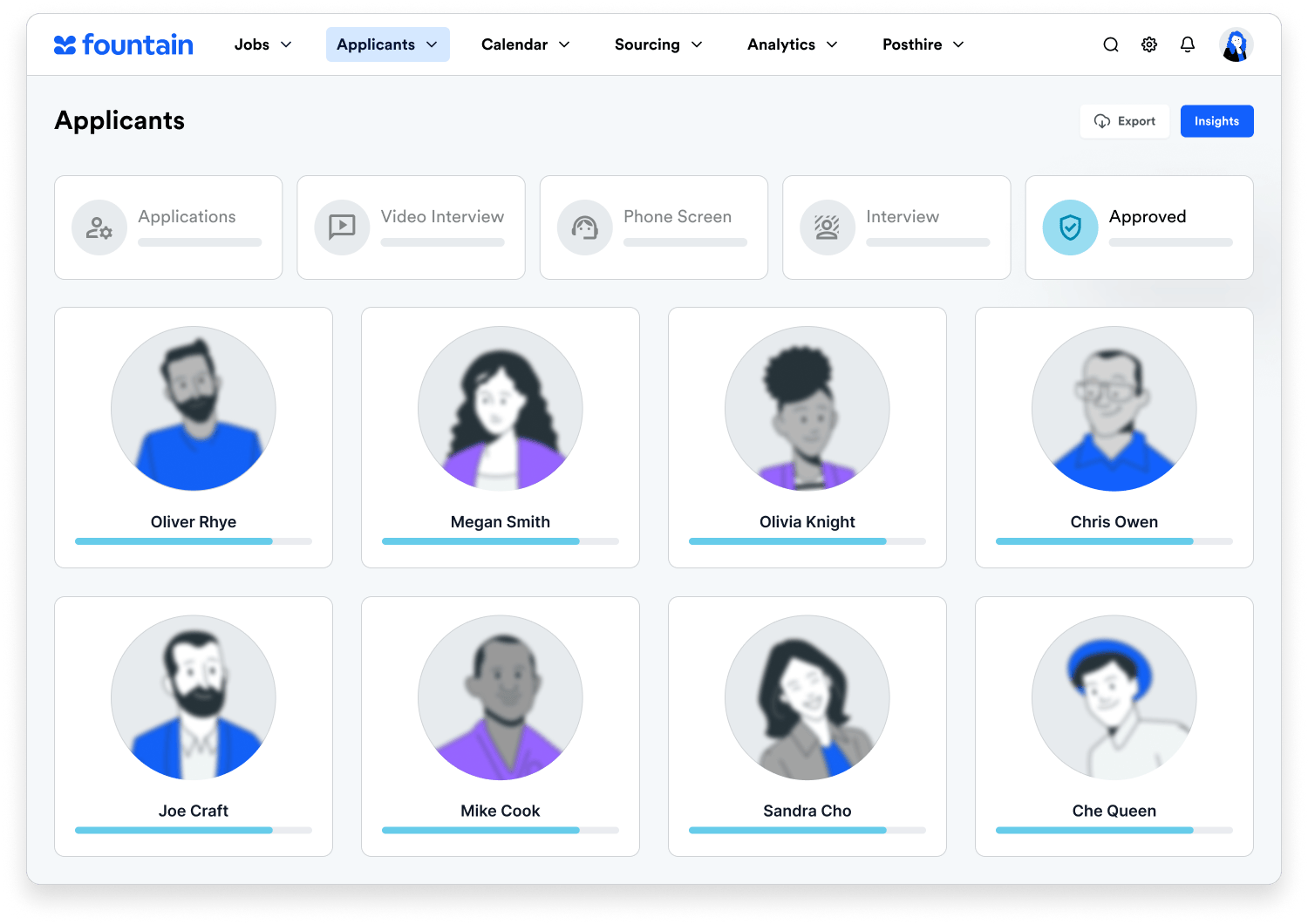Why traditional applicant tracking systems will fail your hiring of frontline workers, and why you need a frontline ATS to get the job done
The pandemic detonated the world of work. Hire rates plummeted and then quickly rebounded two to three months later while outpacing the rate of job openings. But two different outcomes occurred when comparing frontline workers’ roles versus desk-based industries.
In the past 18 months, desk-based industries like finance and IT saw hiring and job openings exceed pre-pandemic levels while quit rates declined. This is not so for frontline industries like hospitality and retail services.
Frontline worker job openings are at their highest levels since 2017, but so are quit rates, and the rate of hiring simply hasn’t kept up. Is the corporate applicant tracking system (ATS) to blame for this gap?
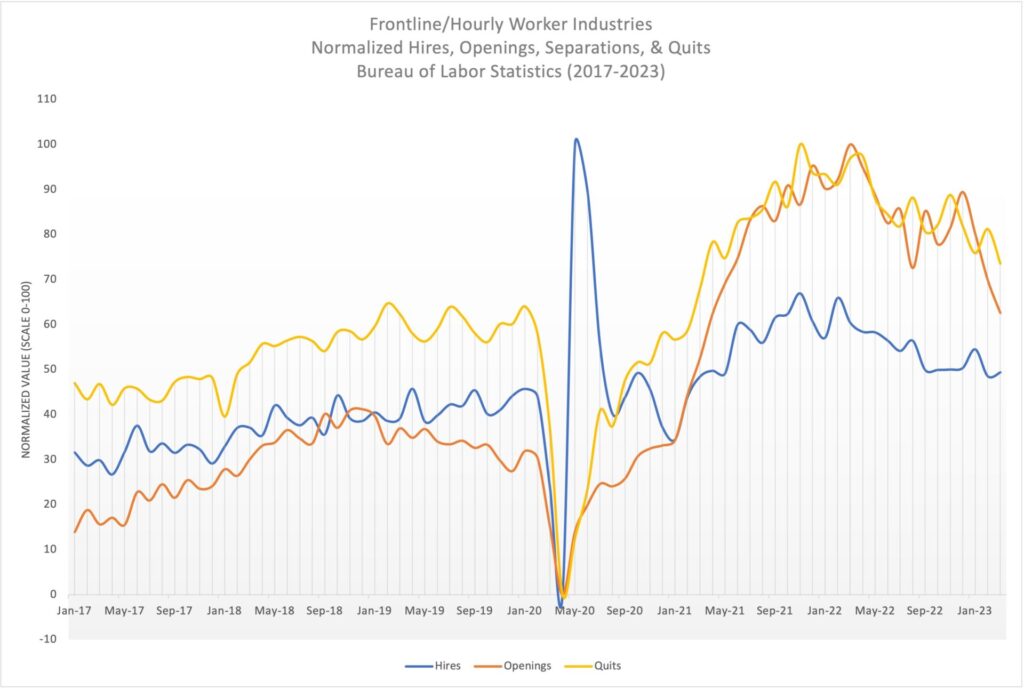
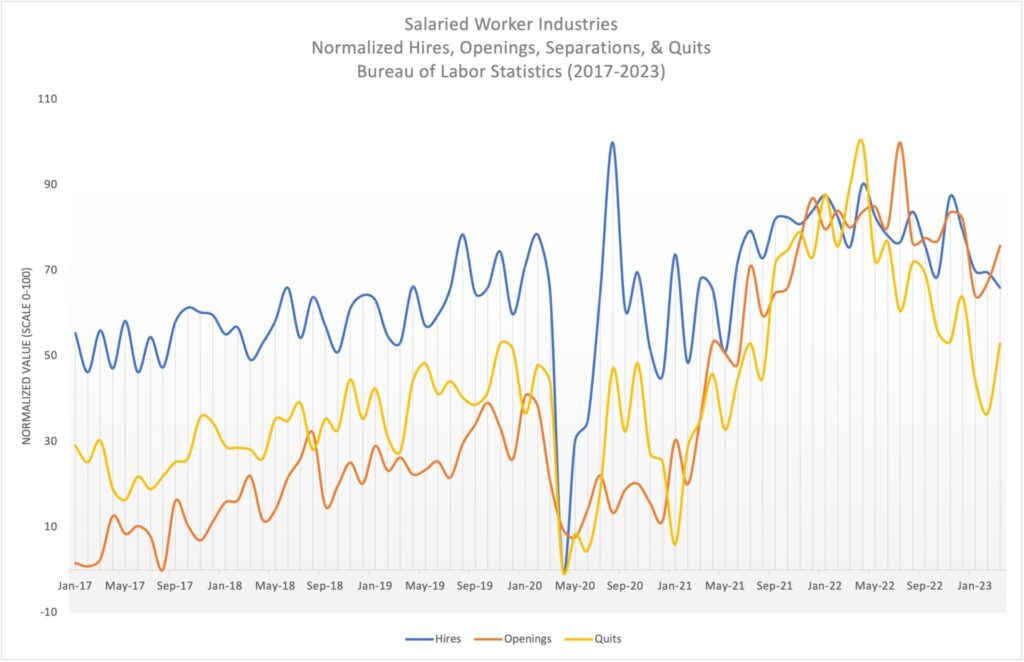
Corporate ATS vs. Frontline ATS: What’s the difference?
When we say “corporate ATS”, we mean software designed for traditional, desk-based employees but utilized even for those working from non-office settings like retail stores or hospitals. But most hiring teams don’t know that different types of workers need different application processes. In this section, we explore why frontline workers would benefit more from a frontline-specific ATS and what that means for your hiring process.
When evaluating why you’re not hiring frontline workers like you used to, ask yourself these three key questions:
- Who are your frontline applicants?
- Who are your frontline recruiters?
- How can you optimize hiring in a way that works for both sides of the application?
Let’s first consider the applicant pool for frontline work in 2023 and beyond. Gen Z now makes up 19% of the U.S. workforce, with a 2% increase every year—and they hold a 37% saturation in the hospitality industry. Fountain’s ATS, which specializes in high volume frontline hiring, sees 29% of its applications come from this generation.
These workers are specifically seeking mobile-first job applications, shift flexibility, and are keen to work for multiple employers. Any desk-based worker will likely apply for a job on a laptop, have a resume handy, a college degree, and a specific set of skills suited to the role. A frontline worker, on the other hand, will apply on their mobile phone at a rate as high as 86% of the time, might be a student or only available part-time, and is looking to grow their skills with your company.
Read now: 4 ways to adapt your talent acquisition suite for hourly hiring
When this type of applicant hits a corporate ATS, they’re most likely to be asked for a log-in, then a resume upload, and then the time-consuming task of entering their work history into form fields. After they submit the application, there’s no assurance they’ll ever hear from a recruiter. A Gen Z student only available to work during their summer break is guaranteed to abandon this type of application and, instead, apply where it’s fast, easy, and engaging.
Research has shown that the fastest job offers also are more likely to be accepted. Fountain found that companies made 80% more hires when their offer came within seven days of the initial application. Benchmarking data places the average hiring time using a corporate ATS at a whopping 25 days.
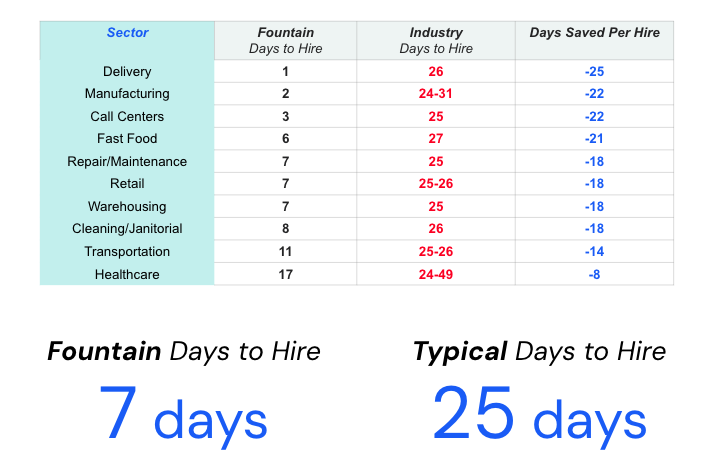
What does this mean? Frontline employers need a faster system.
How a frontline ATS meets workers where they are
With a frontline-specific ATS, speed on the applicant side comes in the form of texting capabilities, interview flexibility—from video recordings to on-demand screenings—24/7 chat widgets, automatic filtering, and immediate offer letters sent, all in the same platform. But there’s a catch: a corporate ATS that provides all of these features is still going to face an optimization issue because frontline recruiters are also a unique population.
Read more: 5 recruitment strategies to attract Gen Z workers
Corporate ATSes are designed for the desk-based recruiter hiring for a desk-based employee at a single location. Once filled, the job requisition is removed. But the frontline sector operates on a vastly different scale. Job requisitions may never close because the employer is hiring for the same hourly role across hundreds of national locations. This also means they’ll receive thousands of applications, and due to low retention rates in this sector, they’re rehiring frequently.
Frontline recruiters need the ability to operate for high volume in addition to moving at lightning speed, but the catch is that they’re not at their desk. Frontline recruiters in many cases are also operating managers busy on the shop or warehouse floor. They have limited computer time, and they’re often covering for the same roles they’re trying to fill. Telling these recruiters to go faster won’t work and, just like with their applicants, providing them with an ATS that isn’t designed for the applications they’re most likely to receive will hurt more than help.
The benefits of a frontline-specific ATS for frontline workers
Employers must consider that their recruiter pool is just as unique as their applicants, and both sides of the application require an agile, frontline-specific ATS to be fully optimized.
There are three areas where this kind of ATS outpaces a corporate system:
- Hiring workflows
- Performance analytics
- Artificial intelligence
Let’s break it down:
Hiring workflows
In a corporate ATS, a new workflow is created for every job requisition, but it’s likely this job requisition may not surface again for some years. The time it takes to set up the workflow is therefore minimized.
For frontline requisitions, the same workflow is often used across hundreds of national locations with only small variations based on regional demands. Recreating this workflow for every identical requisition is vastly time-consuming, and a corporate ATS simply can’t handle the volume.
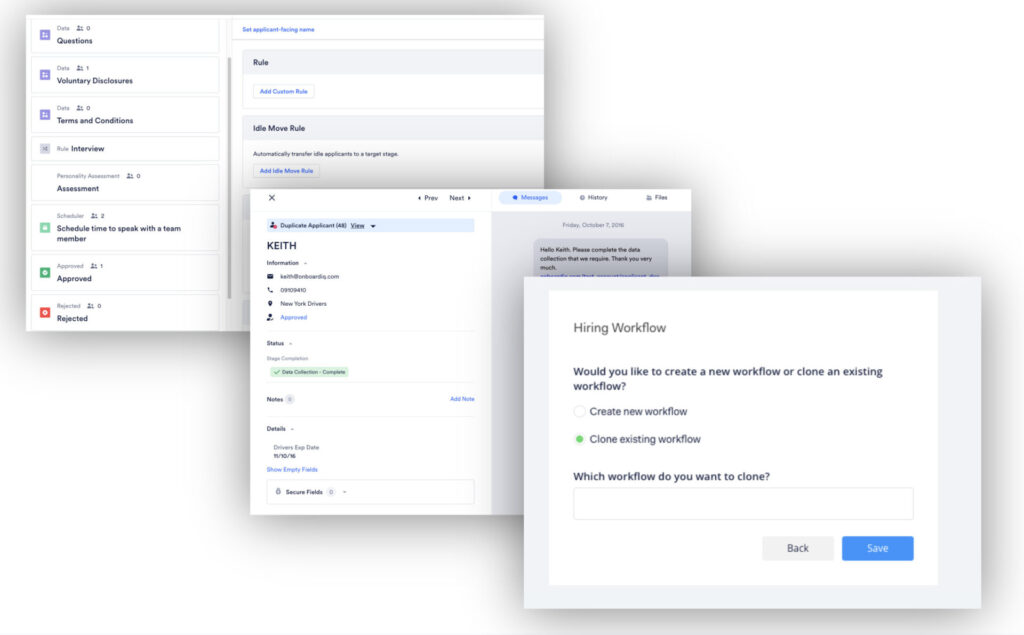
Optimization occurs when recruiters can clone a single workflow across many locations and also make changes that update automatically across all related workflows. Attaching a workflow to multiple job boards can also be done with a single click.
On the applicant side, agile workflows in a frontline-specific ATS allow for branches of applicant experience based on applicant details. For instance, an applicant with an employee referral can move through a workflow with fewer qualification stages and be hired faster.
Similarly, applicants can be automatically scored based on their availability or other factors and prioritized in the hiring process. Automatic rules immediately notify applicants when they’re not a good fit, and applicants don’t have to waste their time in the process.
Performance analytics
Accessing a wide breadth of data is also incredibly useful for knowing what works and replicating successful processes. Frontline-specific ATSes like Fountain offer customizable dashboards with the ability to set and track hiring goals, understand applicant sourcing metrics, review workflow performance, and visualize applicant journeys.
Identifying where applicants drop out of your process offers a key to employing changes that work for the applicant pool you attract—and this can be done at different geographic scales. Widespread analytics access also means every recruiter has access to the same metrics and operates within the same understanding.
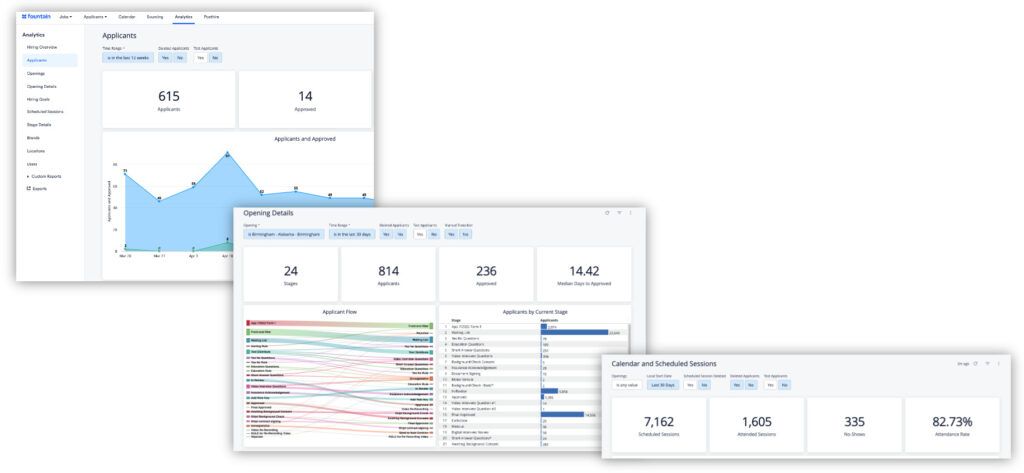
Artificial intelligence
As a final point, frontline-specific ATSes offer the most sophisticated artificial intelligence (AI) that serves the applicant and recruiter alike. The explosion of large language models in the past year allows conversational AI models in the form of web widgets and text communication to handle a vast range of applicant questions without causing applicant frustration. These automated messaging systems are available 24/7 and ready to interact whenever the applicant needs.
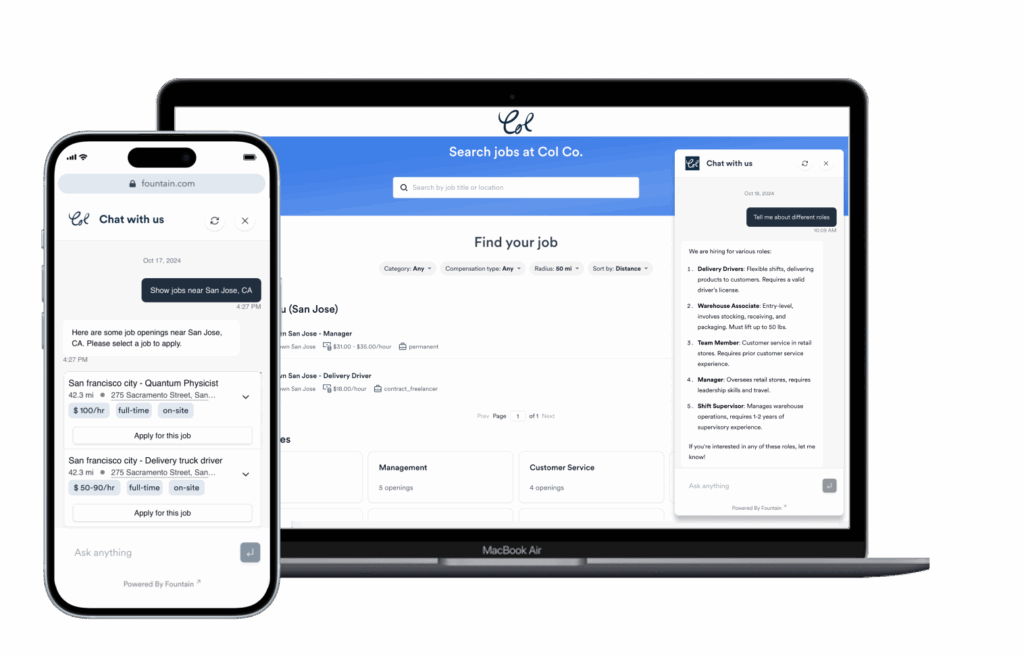
On the recruiter side, Fountain discovered 30% of text communication with applicants could be readily handled by AI while high-complexity messages could be referred by the AI to recruiters for more nuanced responses. This leaves recruiters in the driver’s seat, responding to applicants who either request human contact or require human assistance, while AI handles time-consuming and repetitive questions that are easily answered.
Final thoughts: Where to go from here
A corporate ATS is exactly that: corporate. Employers do not need to rip out a system designed for corporate roles, but they should consider the outlook for their frontline hiring if they’re using a system that will never be optimized for the applicants and recruiters in their workforce today.
Applicants are trending younger and make up a growing portion of the frontline workforce. They’re seeking speedy, mobile-first processes where their status is known. On the other side of the application, frontline recruiters are more likely to be on-site and away from their computers. They’re desperate for workers but don’t have the time to navigate time-consuming systems or review and respond to every applicant.
A frontline-specific ATS that sits alongside a corporate system is the perfect pairing for true optimization, with each system uniquely suited to its users. Flexible workflow construction, large-scale analytics, and state-of-the-art AI are just some of the many offerings a frontline ATS like Fountain provides.
Demoting your corporate ATS doesn’t mean starting from scratch, but it does mean exponential growth for your frontline hiring, decreased time-to-hire, and improved retention.
To learn how to make a frontline ATS like Fountain a part of your hiring strategy, click here to get a free demo!
Sources:

